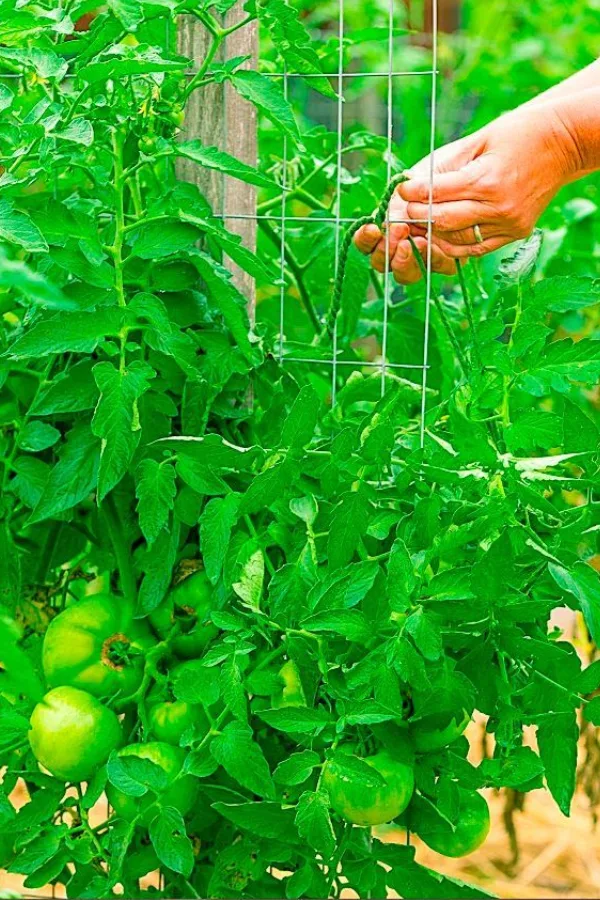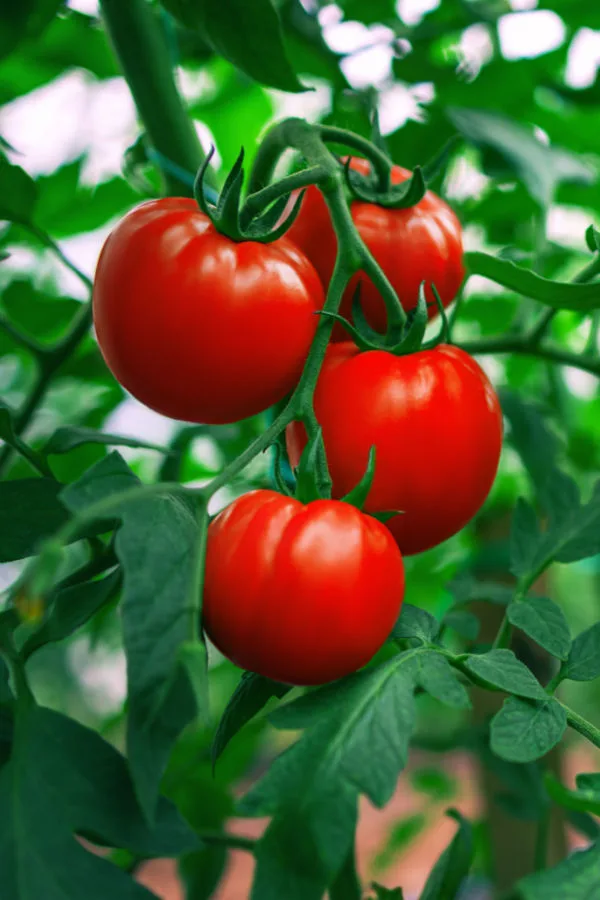Looking for an easy, effective, and most importantly, incredibly inexpensive way to tie up your tomato plants this year?
Properly supporting the main stem and branches of a tomato plant is one of the most critical tasks for helping to keep plants healthy and productive. And yet, this task also happens to be the one chore that many gardeners struggle the most with doing!
For starters, many tomato growers are unsure of just how, when and where to tie up their plants. And then there is knowing which materials you can use for tying to keep plants safe – and which ones can actually cause them harm.

The good news? It doesn’t have to be difficult or expensive to tie up your tomatoes. But one thing is for sure, you do need to do it – because when you leave tomato plants to grow on their own – bad things happen!
Why You Need To Tie Up Tomatoes – The Easiest Way To Tie Up Tomato Plants
So why is tying up tomato plants so important? Because it has a long list of benefits for a tomato plant’s health, vitality and longevity.
First and foremost, it provides protection against Mother Nature. As plants mature and fruit, they become top heavy and can topple easily in summer storms or high winds. And once a plant sustains damage, not only is the fruit on the plant in jeopardy, so is the entire health of the plant.
But just as important, supporting your plants early also protects them from disease and pests. That’s because by keeping foliage and fruit off the ground and out of danger, you make it much more difficult for either to attack your plants.
When plants are left to sprawl on the ground, all sorts of ground dwelling insects have easy access to climb anywhere and everywhere on the plant. Even worse, soil born diseases such as blight can also infect the leaves and the plant when they come in contact with the drooping foliage.
Last but not least, tying up your tomato plants makes it easy to manage, maintain and harvest your crop. Plants that are secure and upright allow for better airflow and circulation. That, in turn, helps to promote better pollination and ripening. And best of all, having plants secure and upright makes harvesting a breeze!

The Easiest Way To Tie Up Tomato Plants – And The Cheapest Too!
The key to success when tying tomato plants up is to use a material that is durable enough to hold plants, but still has flexibility. Materials that are too rigid will cut and damage plants as they grow or move in the wind.
Zip ties, plastic ties and even metal wire ties all fall into this category. Although they are easy to work with, they can actually cause more harm to the plants as they grow. All of these may hold the plants up with plenty of support, but they easily slice into the tender skin of plants. Jute rope and twine are two other materials that can cause injuries to branches as they rub the tender flesh.
There are some good materials that work well. For many, old cotton t-shirts cut into strips do the trick. They are certainly strong enough to hold limbs securely and allow for growth and expansion of stems and shoots.
But cotton t-shirts and strips can be hard to find and cut. Even worse, they can make a garden look a bit unsightly as well. And although old pantyhose also work well too, they can be even harder to find these days!
The Inexpensive Answer – The Easiest Way To Tie Up Tomato Plants
So what is the answer? Over the past 15 years, we have tested a long list of materials and products for tying up our plants. And even though there are many that have worked well, as you will see below, there is one – 100% cotton yarn – that simply stands head and shoulders above all the others.

That’s right – our go-to choice for tying up tomato plants is and will always be a big ball of inexpensive, 100% all-natural cotton yarn. Not only it extremely cost effective, it works incredibly well on plants for strength, give, durability – and even looks!
The Power Of Cotton Yarn – The Easiest Way To Tie Up Tomato Plants
Cotton yarn can usually be purchased in 50 to 100 yard lengths for well under $5 to $10. Cotton yarn is also both strong and flexible. As the plants grow, it allows plenty of movement to keep them safe from rubbing or damaging limbs. Even better, it is also extremely easy to cut and tie off.
But here is the best part of all – if you purchase it in green, it is completely invisible in the garden. In fact, most visitors to our garden ask how we keep our tomatoes growing so straight, because they don’t even see the yarn holding the branches up! Affiliate Product Link: 100% Cotton Yarn – Green
How To Tie Up Tomato Plants With Cotton Yarn
So what is the best way to tie up your tomato plants with yarn? When it comes to securing tomatoes, it all starts with tying off the main stem first.
Start at the base of your tomato plants and secure them to your supports by tying off with two cotton yarn ties. One a few inches off the ground, and another about 6 inches above the soil base. Never tie too tight – just make sure to secure the branch and allow for slight leeway and movement.

This will keep the plant from straying and provide support as it grows larger. Trim off any branches below this point. Bottom pruning your plants is actually another big key to tomato growing success. It also makes tying off a breeze. See: How To Prune Tomato Plants – And Why It’s A Must For Better Tomatoes!
What To Do With Top Branches – The Easiest Way To Tie Up Tomato Plants
For the top branches, we like to weave a few branches across each other and tie them together to the post or cage. This keeps the plants from going in too many directions and gives even more strength to the main branches.
We usually tie a few at the top in the center and a few more on the right and left. This is perfect for helping to fill out the plant canopy. You can carefully move branches as they grow to train them to these three areas. Once the plant has 4 or 5 tie off spots up top, it is usually strong enough to hold.
For us, the remainder of the year we only tie back additional branches that begin to carry an excess amount of fruit. Here is to tying up your tomato plants this year to perfection, and to having your best harvest yet! Happy Gardening – Jim and Mary.
Old World Garden
Jim and Mary Competti have been writing gardening, DIY and recipe articles and books for over 15 years from their 46 acre Ohio farm. The two are frequent speakers on all things gardening and love to travel in their spare time.
As always, feel free to email us at thefarm@owgarden.com with comments, questions, or to simply say hello! You can sign up for our free email list in the subscribe now box in the middle of this article. Follow us on Facebook here : OWG Facebook. This article may contain affiliate links.
